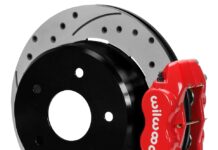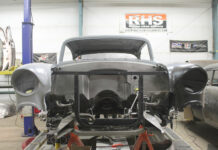Taking Your Air Breathers to New Heights and Dimensions
By Gerry Burger – Photography by the Author
Let’s face it, when it comes to hot rod motors nothing says performance quite like multiple carburetors. Even the uninitiated can gaze under an open hood and announce with authority … “wow, dual-quads” or “three deuces,” tri-power for Pontiac lovers, and the list goes all the way up to six-twos. Of course, having owned my fair share of cars with multiple carbs—and I even own one with “dual-quads” that are actually dual EFI units—I fully understand that while performance may be enhanced, the bigger impact often comes in the form of hot rod eye candy.



Now none of this was lost on my longtime pal Larry Shoaf. A metal man extraordinaire, Shoaf basically hand-formed at least 70 percent of his 1927 Chrysler track roadster. Rescued from the woods, it was the proverbial “rusted to the door handles” example, but being a Mopar guy, Shoaf knew the answer when the owner queried, “When’s the last time you saw a 1927 Chrysler roadster?” And so he hauled them home (yes, remarkably the guy had two 1927 Chrysler roadsters side by side in the woods behind his house) and began to form one very cool track-style roadster. One of the key elements in the design was forming a custom three-piece hood with a trio of Stellings & Hellings air breathers peeking just above the hood line. The carbs would be perched atop a warmed-over 318ci motor, keeping things all Mopar. The induction setup was actually ordered direct from Mopar and included the intake, linkage, and carbs. Originally designed for the 340 Six-Pack motor, the intake fit just fine atop the 318.



Forming the hood was just another example of Shoaf’s metalwork. The opening for the air breathers is surrounded by a raised reveal. There was only one problem. The breathers did not quite rise to the occasion; they were too low on the motor. There was a secondary problem. Due to the angle of the motor and intake manifold, the air breathers were not level with the hood. The solution to that problem was fairly simple: fabricate three air breather spacers to lift each breather to the proper height. But wait, there’s more! Not only were the carburetors at different heights, the spacing between the carburetors was not uniform, either. This meant each riser piece also has a different front-to-rear offset so the carbs are now both level and equally spaced. This same process could be used for dual-quads or six-deuces, the concept remains the same. It is this attention to subtle proportions that separates an average hot rod from a great one.



If your carburetors have a round throat and simply need to be raised, the process may be a bit easier by simply working with round tubing. Actually, Speedway Motors lists air breather spacers in their online catalog. If your carburetor breathes through an irregular shape, or you need to change the front-to-rear spacing, a bit more fabrication is in order. This particular breather adapter transitions from the D-shape opening of a Holley carburetor to the round air filter found on most vintage-style air breathers. Working in aluminum gave Shoaf the opportunity to polish the finished pieces, contributing to the aforementioned eye-candy effect of multiple carbs. While the linkage between the carbs is factory “six-pack” style, a simple Lokar cable will ultimately open the throttle.



The same type adapters could be fabricated in steel or stainless steel, the material is your preference. This is a project easily within reach of the average home hot rod builder and one that pays rewards every time you are behind the wheel of your car. So, without further ado, let’s follow along as Larry Shoaf lifts and relocates three breathers. MR
Sources:
Lokar
(877) 469-7440
Lokar.com
Miller Electric Manufacturing Company
Millerwelds.com
Speedway Motors
(800) 979-0122
Speedwaymotors.com





























